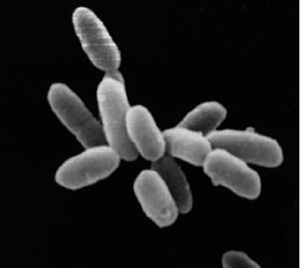Bacteria, Viruses, and ProtistsBacteria Basics |
What are Archaebacteria? |
Archaebacteria (domain Archaea) are primitive bacteria that often live in extreme environments. This domain includes the following: 1) thermophiles (“heat lovers”; see below for more about thermophiles), which live in very hot environments, including the hot sulfur springs of Yellowstone National Park, which reach temperatures ranging from 140 to 176°F (60–80°C). 2) halophiles (“salt lovers”), which live in locations with high concentrations of salinity, such as the Great Salt Lake in Utah (with salinity levels from 15 to 20 percent; seawater normally has a level of salinity of 3 percent); and 3) methanogens that get their energy by using hydrogen gas (H2) to reduce carbon dioxide (CO2) to methane gas (CH4). (For more about organisms in extreme environments, see the chapter “Basics of Biology.”)

Halobacteria (shown here) are an example of Archae-bacteria, a primitive form of bacteria that can survive extreme environments.
